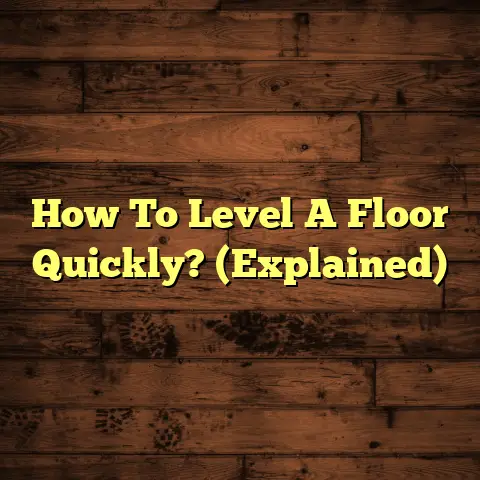Dog Pacing? (1 Flooring Link You Missed!)
I’m Mike, a flooring contractor for over 20 years. And I’ve seen a lot of floors.
But something I’ve noticed, especially talking with clients who are also dog owners, is how much flooring impacts our furry friends.
We often think about the aesthetic appeal, the durability against scratches, or how easy it is to clean up messes.
But what about our dog’s health and well-being?
That’s where pacing comes in.
You might think, “Pacing? My dog just likes to walk around.” And that might be true!
But excessive pacing can be a sign of something more, and the type of flooring you have could be playing a bigger role than you realize.
Let’s dive in and explore how the right flooring can significantly enhance your dog’s ability to move freely and comfortably, potentially preventing joint issues and promoting a healthier, happier life.
Think of it this way: your dog’s paws are their connection to the ground.
And that connection impacts everything from their gait to their mental state.
I’ve seen firsthand how changing a floor can literally change a dog’s life.
The Paw-sitive Impact: Why Exercise Matters
Regular exercise and movement are vital for a dog’s physical and mental health, just like they are for us humans.
Think about it: a dog’s body is designed for movement.
They need to run, play, explore, and yes, even pace!
Here’s why it’s so important:
- Physical Health: Exercise helps maintain a healthy weight, strengthens muscles and bones, and improves cardiovascular health. It’s like giving your dog a full-body tune-up every day.
- Mental Well-being: Movement releases endorphins, which have mood-boosting effects. A tired dog is often a happy dog, less prone to anxiety and destructive behaviors.
- Joint Health: Regular, appropriate exercise can help lubricate joints and prevent stiffness, especially important for older dogs or breeds prone to joint issues like hip dysplasia.
But here’s the thing: how your dog moves is just as important as how much they move.
And that’s where flooring comes in.
A slippery floor can make a dog hesitant to move, leading to less activity and potential muscle weakness.
A hard floor can exacerbate joint pain, making pacing uncomfortable and even painful.
I once worked with a client whose senior Labrador, Buster, had started pacing constantly.
They thought it was just old age.
But after switching to a more supportive flooring, Buster’s pacing decreased significantly, and he seemed much more comfortable and happy.
It was like he could finally move without pain!
According to a study published in the Journal of Veterinary Internal Medicine, environmental factors, including flooring, can significantly impact the mobility and comfort of dogs with osteoarthritis.
The study highlighted that dogs with access to softer, more forgiving surfaces exhibited less pain and improved gait compared to those primarily on hard surfaces.
Section 1: Understanding Dog Pacing
So, what exactly is dog pacing?
Simply put, it’s repetitive walking back and forth in a consistent pattern.
Think of it as your dog walking a well-worn path through your living room.
But why do they do it?
There are several reasons, both physiological and psychological:
-
Anxiety: Pacing can be a sign of stress or anxiety. It’s like a nervous habit, a way for your dog to release pent-up energy and cope with uncomfortable feelings.
-
Boredom: A bored dog is often a restless dog. Pacing can be a way to alleviate boredom and seek stimulation, especially if they’re not getting enough exercise or mental enrichment.
-
Energy Levels: Some dogs simply have more energy than others. Pacing can be a way to burn off excess energy, especially if they’re confined indoors for extended periods.
-
Medical Conditions: In some cases, pacing can be a symptom of an underlying medical condition, such as cognitive dysfunction (doggy dementia), neurological issues, or pain.
-
Attention Seeking: Sometimes, dogs learn that pacing gets them attention from their owners, even if it’s just a concerned look or a gentle pat.
Pacing can serve as a coping mechanism, a way for your dog to deal with whatever they’re experiencing.
It’s their way of communicating their needs to you.
But it’s important to remember that not all pacing is bad.
Some dogs naturally pace more than others, especially certain breeds known for their high energy levels.
The key is to understand your dog’s normal behavior and to notice any changes or increases in pacing that might indicate a problem.
I always tell my clients, “Know your dog. You’re their best advocate.”
Section 2: The Importance of Flooring for Dog Health
Now, let’s talk about flooring.
It’s not just about aesthetics; it’s about your dog’s health and well-being.
Here’s a rundown of common flooring types and their pros and cons for dog mobility:
| Flooring Type | Pros | Cons |
|---|---|---|
| Hardwood | Looks great, relatively durable, easy to clean. | Can be slippery, especially for dogs with long hair or weak paws. Can be hard on joints. |
| Laminate | Affordable, scratch-resistant, easy to clean. | Very slippery, offers little cushioning, can be noisy. |
| Tile | Durable, waterproof, easy to clean. | Very hard and cold, can be slippery, especially when wet. Can be tough on joints. |
| Carpet | Soft, provides good grip, warm. | Can trap dirt, hair, and odors. Difficult to clean, can be a breeding ground for allergens. |
| Rubber | Excellent grip, shock-absorbent, durable, easy to clean. | Can be more expensive, may not be aesthetically pleasing to everyone. |
| Cork | Eco-friendly, shock-absorbent, warm, naturally antimicrobial. | Can be susceptible to scratches and dents, requires sealing. |
| Vinyl | Durable, waterproof, relatively affordable, comes in a variety of styles. | Can be slippery depending on the finish, some types may contain harmful chemicals. |
As you can see, each flooring type has its advantages and disadvantages.
But when it comes to pacing, the key factors to consider are grip, cushioning, and joint impact.
A slippery floor can force your dog to work harder to maintain their balance, putting extra strain on their joints.
This can be especially problematic for older dogs or those with pre-existing conditions like arthritis.
I’ve seen dogs completely change their gait on different surfaces.
A dog that shuffles and slides on hardwood might suddenly move with confidence and ease on a carpeted surface.
It’s all about providing them with a surface that supports their natural movement.
Think about it this way: would you want to run a marathon on concrete or a soft, grassy field?
Your dog feels the same way about their flooring!
Section 3: The One Flooring Link You Missed
Okay, so we’ve talked about the importance of flooring and the different types available.
But what’s the one flooring link you’ve been missing when it comes to your pacing dog?
In my experience, rubber flooring stands out as a particularly beneficial option for dogs that exhibit pacing behavior.
Now, I know what you might be thinking: “Rubber flooring? That sounds like a gym!”
And while it’s true that rubber flooring is commonly used in gyms and fitness centers, it’s also becoming increasingly popular in homes, especially for pet owners.
Here’s why it’s so great for pacing dogs:
-
Excellent Grip: Rubber flooring provides superior grip, preventing slips and slides. This allows your dog to move with confidence and reduces the risk of injury.
-
Shock-Absorbent: Rubber is naturally shock-absorbent, cushioning your dog’s joints with every step. This is especially important for older dogs or those with arthritis.
-
Durable: Rubber flooring is incredibly durable and can withstand even the most enthusiastic pacing sessions. It’s resistant to scratches, dents, and stains, making it a long-lasting investment.
-
Easy to Clean: Rubber flooring is easy to clean and maintain. Simply sweep or mop up any messes, and you’re good to go.
-
Comfortable: Believe it or not, rubber flooring is actually quite comfortable to walk on, even for humans! It has a slight give that feels much better underfoot than hard surfaces like tile or concrete.
Now, I know that aesthetics are important, and rubber flooring might not be everyone’s cup of tea.
But the good news is that it comes in a variety of styles and colors, so you can find something that complements your home décor.
You can even get rubber flooring that looks like wood or tile!
I had a client, Sarah, whose Border Collie, Sparky, was a chronic pacer.
She had hardwood floors throughout her house, and Sparky would constantly pace back and forth, especially when he was anxious.
Sarah was worried about his joints and the wear and tear on her floors.
After switching to rubber flooring in Sparky’s favorite pacing areas, Sarah noticed a dramatic difference.
Sparky paced less, seemed more relaxed, and moved with greater ease.
She told me, “It’s like he finally has a safe and comfortable place to be himself.”
That’s the power of the right flooring!
Section 4: Observing and Analyzing Your Dog’s Pacing
Okay, so you’re intrigued by the idea of rubber flooring, but you’re not sure if it’s the right solution for your dog.
The first step is to observe and analyze your dog’s pacing behavior.
Here are some things to look for:
-
Frequency: How often does your dog pace? Is it constant, or does it only happen at certain times of day or in certain situations?
-
Intensity: How intensely does your dog pace? Are they walking calmly, or are they frantic and agitated?
-
Location: Where does your dog pace? Is it always in the same spot, or do they move around?
-
Triggers: What seems to trigger the pacing? Is it related to anxiety, boredom, or something else?
-
Body Language: What is your dog’s body language like when they’re pacing? Are they tense, relaxed, or somewhere in between?
Pay attention to any signs that your dog might be uncomfortable with their current flooring.
Do they slip or slide when they walk?
Do they seem hesitant to move on certain surfaces?
Do they lick their paws excessively after pacing?
These could all be signs that your flooring is contributing to their pacing behavior.
I recommend keeping a journal of your dog’s pacing patterns and behaviors.
Note the time of day, the location, any potential triggers, and your dog’s body language.
This information can be invaluable when talking to your veterinarian or a professional dog trainer.
It can also help you identify patterns and make informed decisions about your dog’s environment.
Remember, you know your dog best.
Trust your instincts and don’t hesitate to seek professional help if you’re concerned about their pacing behavior.
Section 5: The Connection Between Physical Environment and Behavior
Flooring is just one piece of the puzzle.
Your dog’s overall physical environment plays a significant role in their behavior, including pacing.
Consider these factors:
-
Space: Does your dog have enough space to move around comfortably? A cramped environment can lead to anxiety and increased pacing.
-
Layout: Is your home layout conducive to your dog’s needs? Are there clear pathways for them to move around without feeling confined?
-
Stimulation: Does your dog have access to plenty of toys, puzzles, and other forms of mental and physical stimulation? Boredom can be a major trigger for pacing.
-
Comfort: Does your dog have a comfortable place to rest and relax? A cozy bed or a quiet corner can help reduce anxiety and promote calmness.
Creating a dog-friendly environment is about more than just providing food and water.
It’s about understanding your dog’s needs and creating a space that supports their physical and mental well-being.
Think about it from your dog’s perspective.
What would make them feel safe, comfortable, and stimulated?
Here are some tips for creating a dog-friendly environment:
-
Provide plenty of space: Make sure your dog has enough room to move around comfortably, both indoors and outdoors.
-
Create clear pathways: Arrange your furniture in a way that allows your dog to move freely without feeling confined.
-
Offer a variety of toys and puzzles: Keep your dog entertained and stimulated with a rotating selection of toys and puzzles.
-
Provide a comfortable resting place: Make sure your dog has a cozy bed or a quiet corner where they can relax and feel safe.
-
Establish a routine: Dogs thrive on routine. Establishing a consistent schedule for feeding, exercise, and playtime can help reduce anxiety and promote calmness.
By creating a well-designed living space with appropriate flooring and plenty of stimulation, you can significantly reduce anxiety and promote positive pacing behavior in your dog.
Conclusion: Reinforcing the Health Benefits of Proper Flooring
We’ve covered a lot of ground, haven’t we?
From understanding dog pacing to exploring different flooring types and creating a dog-friendly environment.
The key takeaway is that your dog’s flooring plays a crucial role in their health and well-being, especially when it comes to pacing.
Pacing isn’t just a quirky behavior; it can be a sign of underlying anxiety, boredom, or even medical issues.
And the type of flooring your dog walks on can either exacerbate these issues or help alleviate them.
I truly believe that rubber flooring is a game- changer for pacing dogs.
Its superior grip, shock-absorbent properties, and durability make it an ideal choice for providing a safe and comfortable surface for your furry friend to move on.
But ultimately, the best flooring choice for your dog depends on their individual needs and circumstances.
I encourage you to consider your dog’s pacing behavior seriously and to evaluate your current flooring choices.
Talk to your veterinarian or a professional dog trainer for guidance, and don’t hesitate to experiment with different flooring options until you find what works best for your dog.
Your dog’s health and well-being are worth the investment.
So, take action today!
Explore the benefits of rubber flooring or other dog-friendly flooring options, and prioritize your dog’s health and happiness.
They’ll thank you for it with every happy wag of their tail!
And remember, a happy dog makes for a happy home!





